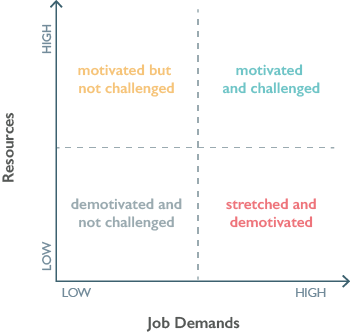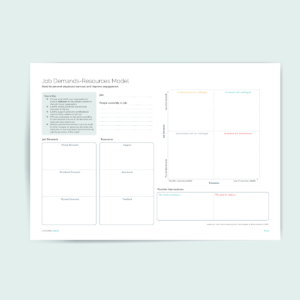With so much to do, it can be challenging to know what elements of an employee’s job you need to focus on in order to improve their performance.
This model and free downloadable resource provides you with a practical way to increase employee engagement, prevent burnout and identity interventions to improve performance. Enjoy!
The Job Demands-Resources (JD-R) Model
The ‘Job Demands-Resources’ or ‘JD-R model’ was developed through research into stress and motivation in the workplace.How demanding a role is – i.e. the physical, emotional or mental effort required to do that role – combined with the resource that is made available – support, autonomy and feedback – can predict how susceptible an employee is to burnout and how engaged they are at work[mfn referencenumber=”1″]Bakker, A., Demerouti, E. & Sanz-Vergel, A. (2014). Burnout and Work Engagement: The JD–R Approach. The Annual Review of Organizational Psychology and Organizational Behavior.[/mfn].
The model explores the interaction between two key areas:
- Job Demands
- Resources

Job demands
One of the reasons it’s so important to look at the demands of a job and the resources that are available together is that research has found that burnout and engagement are polar opposites to each other[mfn referencenumber=”3″]Demerouti, E., Mostert, K. & Bakker, A. (2010). Burnout and Work Engagement: A Thorough Investigation of the Independency of Both Constructs. Journal of Occupational Health Psychology.[/mfn]. If an employee is highly engaged at work, it prevents them from becoming burnt out; conversely, if they are burnt out, that indicates they are not engaged.
The type of demands vary according to the role; for example, the role of a sales consultant would have a mixture of mental demands (responding to client enquiries), emotional demands (anxiety about meeting sales targets) and physical demands (lots of travel and late evenings with clients).
A store manager would have slightly different mixture of mental (monitoring stock levels), emotional (responding to demanding customers) and physical demands (long hours on their feet).
Role resources
Just like job demands, resources will vary according to the position. For example, a teacher could be offered support (regular meetings with peers to discuss challenges), autonomy (able to plan their lesson structure independently) and feedback (from more experienced colleagues on a regular basis).
Employees who have multiple resources available to them are more likely to cope with the demands of their job effectively. Additionally, when a job is particularly demanding, the resources available become even more important.

What does the ideal role look like?
According to the JD-R model, the ideal role is one that is both demanding and supportive (i.e. ‘High Job Demands’ & ‘High Resources’); however, if you just have one without the other – you run into trouble.
For example, if there’s too much resource and not enough demand, employees will become disengaged. Too many demands and not enough support, results in exhaustion[mfn referencenumber=”7″]Demerouti, E., Bakker, A., Nachreiner, F. & Schaufeli, W. (2001). The Job Demands-Resources Model of Burnout. Journal of Applied Psychology.[/mfn].
Using the tool in your organisation
Okay, the theory is all well and good, but how can you use the model to make improvements within your organisation? First, download the free PDF resource we have made for you.Step 1: Pick a job role in your organisation
Starting by choosing a role within your organisation that you want to explore in detail.
You can plot out multiple employees in one go provided they are in the same role; this is because the job demands and type of resources that your organisation can offer will vary between roles.
Step 2: Map out job demands
On the PDF, list the different job demands that exist for that role. They can be mental, emotional or physical depending on the position.
Try to think of all the possible demands for the role you’re mapping out. For example, if you’re mapping out the role of an office administrator, not everyone who has that job in your organisation will work long days, be required to work on Saturdays or have a demanding colleague but some will. Include all the possible job demands for anyone in that role.
Mental Demands:
- Time management
- Calculating of budgets
Emotional Demands:
- Stressful targets
- Time pressures
- Feelings of uncertainty
Physical Demands:
- Long Days
- Shift work
- An unpleasant working environment
Part 3: Map out the resources available
Next, list the resources the organisation is offering (e.g. 1-2-1 time with their manager, administrative support etc.) as well as the resources the organisation could be offering (e.g. access to an external coach, time off after busy periods etc.).
Resources fall into one of three category types: support, autonomy, and feedback. They describe anything that helps or enables the employee in that job to:
- Achieve the goals of that role
- Reduce the mental, emotional or physical demands of the role
- Enable personal growth or professional development
Some examples to get you started are:
- A mentor or coach
- Regular training
2. Autonomy:
- Flexible working arrangements
- Space for independent decision making
3. Feedback:
- 1-2-1 performance management meetings
- Shadowing of key meetings
Part 4: Plot your employees
Now you’ve listed out the elements that make up the two domains of the model – ‘Job Demands’ and ‘Resources’ – it’s time to think about where your employees are and plot them on the graph.
- People who meet all of the job demands will be towards the top. Individuals who aren’t being exposed to all the possible demands of a role that will be towards the bottom.
- Are employees being given all the potential resources that the organisation could offer them? If they are, place them towards the right of the axis. If not, they should be towards the left.
Think about both the job and what the reality is for that person.
Part 5: Identity interventions
How many employees have high demand, high resource roles? How many are not in a desirable location?
For those who are not in desirable locations on the model, from the ‘Job Demands’ and ‘Resources’ boxes, start to identity what interventions you can provide to adjust the job demands or resources.
This model and free resource provides you with a practical way to improve the engagement of your employees, forecast the conditions that could cause them to burnout and identity interventions to improve their performance in the workplace.
If you are looking for someone to work with you on this or other critical areas that will impact the success of your organisation, do get in touch – we’d love to hear from you.
